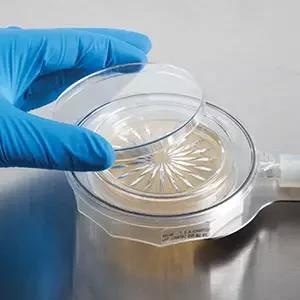Aseptic processing aims to preserve product sterility during assembly using sterile components. Its purpose is to prevent microbial contamination.
This article provides supporting data for the validation of a single-use microbial sampler impactor that includes a preloaded agar plate.
 Image Credit: Particle Measuring Systems
Image Credit: Particle Measuring Systems
Abstract
- Julius R. Petri invented the Petri plate over 120 years ago while working in Robert Koch's laboratory.
- The Petri plate remains a widely recognized and straightforward device commonly utilized in microbiology laboratories.
- As time passed, the early glass Petri plates were replaced by single-use, sterile polystyrene Petri plates.
- The Petri plate was recently hailed as one of the most enduring and influential designs in microbiological instrumentation, as discussed in a 2014 American Pharmaceutical Review article by C. Denoya.
- Petri plates find application in microbial air monitoring, where a specific volume of air is directed onto the agar surface (active air sampling). Microbial contaminants in the air affect the agar surface, and colonies can be counted after incubation. During this process, the lid of an agar plate is manually removed when loading it into a stainless steel sampling device, which poses a risk of operator-induced contamination, resulting in a "false positive."
- The work presented here summarizes the validation of an innovative, single-use, sterile, transparent plastic impactor housing an integrated agar culture media plate.
- This design can serve as an alternative to stainless steel impactors. The single-use device eliminates the need for traditional agar plates and reduces the need for operator involvement in plate substitution, exposure, and removal.
- Data on the performance validation and the advantages of implementing this single-use device in clean rooms for aseptic manufacturing are presented below.
About Particle Measuring Systems
Particle Measuring Systems has 35 years experience designing, manufacturing, and servicing microcontamination monitoring instrumentation and software used for detecting particles in air, liquid, and gas stream as well as molecular contamination monitoring.
Specific applications include cleanroom monitoring, parenteral sampling, filter and in-line testing in deionized water and process chemicals, and point-of-use monitoring of inert gases and in-situ particle monitoring. Specialty monitoring includes parts cleanliness testing with a highly automated solution.
Particle measuring systems
Whether you want to protect product or meet industry requirements, such as ISO 14644, USP 797, or GMP, Particle Measuring Systems has a large variety of particle counters and molecular monitors to meet your needs. With 35 years experience, we have the proven reliability to support your application.
Particle counters
Protect your product with our reliable particle counters. We have airborne, portable, and liquid particle counters for a wide variety of applications including DI water, chemicals, and cleanroom monitoring. Compare particle counters or learn how to monitor your cleanroom or product by reading our papers.
Molecular contamination monitors
Molecular contamination creates costly problems to high value products, production processes, and equipment surfaces. We have solutions for both Airborne Molecular contamination (AMC) and Surface Molecular contamination (SMC). With parts-per-trillion limits of detection, real-time sampling, NIST traceable calibrations, and various data analysis packages, you can monitor in confidence.
Gas detectors
If you need gas detectors for process control or continuous emissions monitoring, we can help. Get real-time, reliable results with our ammonia, hydrogen fluoride, and chlorine detectors for worker protections, CEMs, and pollution monitoring.
Sponsored Content Policy: News-Medical.net publishes articles and related content that may be derived from sources where we have existing commercial relationships, provided such content adds value to the core editorial ethos of News-Medical.Net which is to educate and inform site visitors interested in medical research, science, medical devices and treatments.